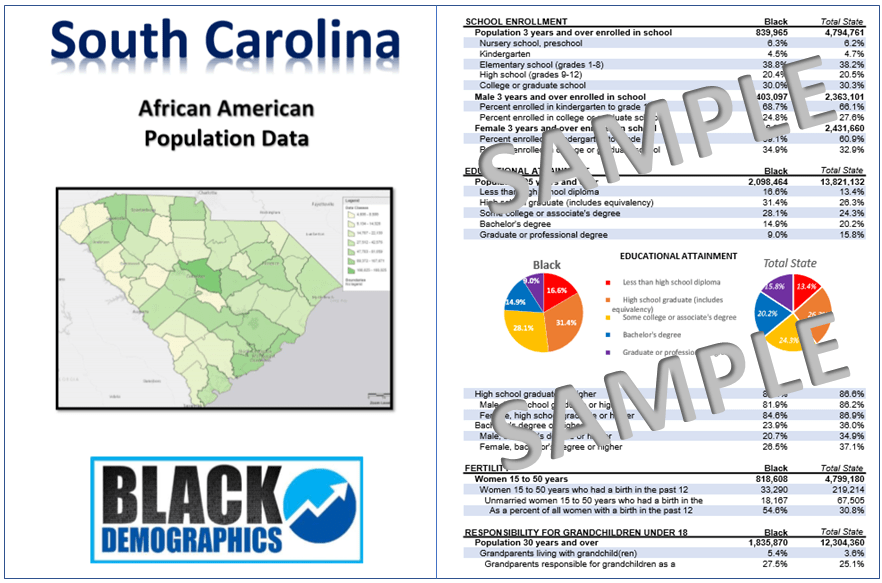South Carolina Black Population
According to the 2017 Census Bureau the state of South Carolina has the 15th largest Black population in the United States with 1,428,796 African Americans making up 28% of the state total.
| State Data | Black | Total State |
| Median household income | $32,175 | $50,570 |
| Bachelor’s degree or higher | 14.8% | 28.0% |
| Family poverty rate | 21.2% | 11.3% |
| Percentage households Married-couple families | 29.1% | 47.3% |
| Homeowner rate | 52.8% | 68.7% |
Source: U.S. Census Bureau, 2017 American Community Survey 1-Year Estimates
Black Metro Population | Percent
–Columbia Metro; 252,329 | 32.9%
–Charleston-N Charleston-Summerville Metro; 182,363 | 27.4%
–Greenville-Mauldin-Easley Metro ; 105,169 | 16.5%
-Florence Metro; 84,667 | 41.2%
–Spartanburg Metro; 58,115 | 20.4%
-Orangeburg Micro; 57,286 | 61.9%
The history of South Carolina is important to the African American population. Approximately 52% of all captives of slavery in the United States landed in Charleston which was the largest slave port in North America.
In 1860, just five years before the Civil War, the majority (57%) of South Carolina’s population were enslaved African Americans. The percentage was even larger on the coast and on the many sea island rice plantations where the population was closer to 90% Black. White plantation owners and workers were more susceptible to malaria therefore rice plantations were often run by or with the help of enslaved overseers. The lack of White oversight and interaction allowed the enslaved to blend only with each other keeping more of their African culture than anywhere else in the nation.
That sea island culture today is known as Gulluh and many of the islands are referred to as Gulluh Islands. Sometimes the word Geechee is used which is also considered derogatory by some. According to DNA studies African Americans who live on the Gulluh islands are the most African of all African Americans (about 96% African). This is due to the White slave owners lack of access to the Black female enslaved population compared to the rest of the slave-holding states. This is strikingly different than the American Black population as a whole which has on average about 24% European DNA.
During the decades after the Reconstruction period Whites in the South began to tighten their grip on power by enacting and reinforcing Jim Crow legislation. Because of this new anti-black legislation combined with national disasters which ended rice cultivation and crippled cotton production, African Americans began leaving South Carolina in large numbers for northern cities such as Philadelphia and New York. By 1930 the White population eclipsed the Black population in the state for the first time.
Today the Black population of South Carolina is less than 30% and the percentage continues to decrease unlike its neighbor Georgia where the Black percentage has been increasing rapidly.
The once Black majority city of Charleston recently lost its a large percentage of its Black residents to nearby suburbs due to gentrification similar to the racial demographic patterns of many of America’s cities today.



